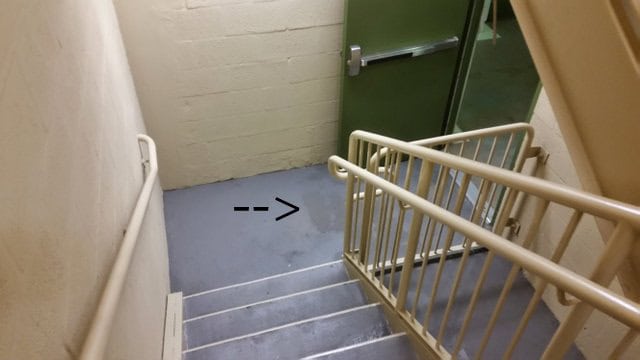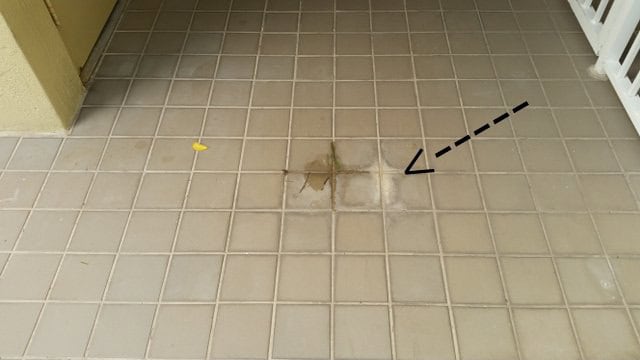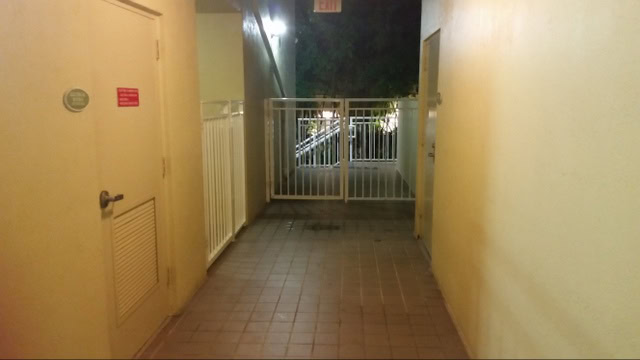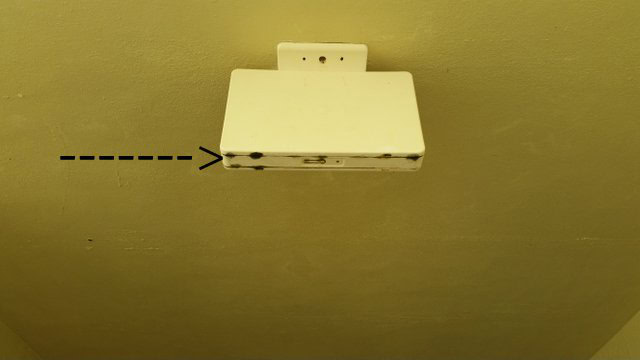
If you slip and fall at an apartment building, you may be able to get compensated. To do so, you’ll need some evidence that the apartment complex’s negligence caused your fall.
This article is specific to Florida apartment building slip and fall claims. I wrote separate articles on:
- Slip and Fall claims against condominiums in Florida
- Trip and fall claims against Florida condominiums and apartments
- General injury claims at Florida condominiums and apartment buildings.
Table of contents
- How Much is a Slip and Fall at an Apartment Building or Condo Worth?
- What’s the biggest factor that affects how much you may get?
- Can you still get a settlement if paramedics did not take you to the hospital?
- Is your case harder if you live at the apartment complex where you slip and fall?
- What If a Tenant Only Has 1 Way to Leave a Property and Is Hurt By a Danger?
- Falls on a Staircase with Broken Tile or Missing Step
- Falls on Stairs at an Apartment Building
- Slip and Falls on Water That Blows in Through the Front Door
- Slip and Falls from Water That Leaks From The Ceiling or Roof.
- How can you get the apartment complex’s insurance information?
- Means of Egress (for buildings over 3 stories)
- See if I Can Represent you for Your Injury in Florida
How Much is a Slip and Fall at an Apartment Building or Condo Worth?
The injured person may want to try to figure out how much your injury case may be worth. You can try looking at past Florida settlements and verdicts in similar cases. That’s the way attorneys value these cases.
But settlements and verdicts are most helpful if they itemize each category of damages. If you don’t know the breakdown of the damages, reading about settlement or verdicts can be almost useless.
The pain and suffering component of the settlement value of your case is what many people want to know.
What’s the biggest factor that affects how much you may get?
It’s how badly you are injured. The worse your injury, the bigger the possible settlement. For example, someone who has a ankle fracture that requires a plate and screws has a case that is potentially worth much more than someone who just has ankle pain (but no broken bone).
But just because you have a big injury does not mean that you have a good case. You still need the apartment complex or condo association to have done something wrong that caused you to slip and fall.
And even if they did something wrong that caused you to get badly injured, you need to properly document your case. You want to make the insurance adjuster’s job as easy as possible to pay you fair value for your claim.
Why calling 911 can be a huge factor in your slip and fall case
In any personal injury case, you want to be able to show that you were injured where and when you say you were. You want to make your case easy to prove. The insurance company for the apartment complex or condo will assign an adjuster to handle your case.
That adjuster will need proof that you were actually injured when and where you say you were. Thus, you should call 911 if you slip and fall and are badly injured.
You can then request the 911 recorded call from the county where you were injured. Request that call quickly because the county usually only saves them for a short period of time.
The 911 call is especially important if all of these three things did not take happen:
- Paramedics did not come to the accident scene immediately after you were injured
- The apartment complex or condo does not have surveillance video that shows you slipping and falling
- You did not report the incident to the condo or apartment complex quickly after you fell.
Why the Paramedics Coming to the Scene Can Help Your Claim
If paramedics came to the scene and examined you, this can be great for proving that you were injured at the apartment complex or condo. Even if you don’t take the ambulance to the hospital, the paramedics will create a medical record that lists the address where they met you at.
If the paramedics don’t take you to the hospital, you will not be charged. I’ve never seen a charge (in Florida) when the paramedics did not take my client to the hospital.
Of course, the paramedics will also write down your body part where you are complaining of pain. Their report will also say how you claim that you were injured.
So if you tell the paramedics that were injured because of a loose or broken handrail, they may write this in their report. Their report may be a important piece of evidence in your claim.
Again, this is especially true if their isn’t surveillance that shows your slip and fall. It’s also true if an employee of the apartment complex or condo did not see you fall.
Can you still get a settlement if paramedics did not take you to the hospital?
Possibly. However, if you didn’t report the accident and you did not call 911, the condo or apartment complex’s insurance company will likely want you to give them a statement. Of course, you still need to show that the apartment complex or condo did something wrong to cause your fall.
We never allow a recorded statements. Their attorney can get a recorded statement (which is called a deposition) if we sue.
Is your case harder if you live at the apartment complex where you slip and fall?
Yes, if you slipped or stumbled on something that you’ve walked by many times in the past. For example, let’s say that you claim that you fell while walking down the stairs due to a broken or loose handrail.
The insurance adjuster may argue that if you had walked by the handrail many times in the past, you should have known that it was broken. They may argue that more fault should be placed on you for this.
Remember:
The total value of your case is reduced by your percentage of fault. So if you’re 30% at fault, you’re only entitled to get 70% of the full value of your case.
In a state like Florida, even if you are 50% or more at fault, you can still get compensation for your claim. Florida is a very generous state in this regard.
However, the case value is reduced by your percentage of fault.
What If a Tenant Only Has 1 Way to Leave a Property and Is Hurt By a Danger?
A tenant, with only one way to leave, doesn’t assume the risk of the danger created by the landlord. Conroy v. Briley, 191 So.2d 601 (Fla. App.1st 1966).
For example, assume that the only way that a tenant can leave an apartment building is by using one stairway. Assume that the building code and a regulation/rule requires that a handrail is used on this stairway.
There is no handrail. While you’re descending the stairway, you (a tenant) fall down the stairs. You suffer severe injuries.
The violation of the city ordinance and the regulation is, at the least, prima facie evidence of negligence. This is good for the value of your case.
You should also argue to the apartment building’s insurance company, that a court won’t let a jury place any blame on you.
This assumes that you were walking down the stairs in your usual manner, when you fell.
Since you only had one method of egress (1 way to leave), tell the apartment building’s insurer that you didn’t assume the risk of the danger – no handrail – created by the landlord.
Tell the apartment building’s insurer that you want full value for your injuries. If you’re a heavy person, the adjuster may reduce the value of your slip and fall case.
Falls on a Staircase with Broken Tile or Missing Step
A step on a staircase may break at a apartment complex. If this happens, the apartment complex should place a warning sign next to the step.
They should immediately block of this area. The association or property manager should fix the step as soon as possible.
The apartment building owner may be liable if they do not warn and fix the hazard. The injured person may also have a claim for compensation against the property manager.
Falls on Stairs at an Apartment Building
If you injured yourself from a slip and fell while walking down the steps (stairs) in an apartment complex or townhouse, you may have a case if one of the things below caused your injury.
You must show that the staircase was a dangerous condition. Some dangerous conditions may be:
– Wrong paint on steps makes stairs too slippery.
– The staircase did not have a handrail and it should have had one.
– The staircase had a broken handrail or the wrong type of handrail.
– One of the steps was chipped.
– The step that you fell on did not have anti-slip stair tread (traction tape). This generally applies to commercial properties (private businesses). I don’t believe that anti-slip tread is required in homes.
– The height of some of the steps were of different proportions.
Learn more about Florida staircase accident claims.
Water Dripping from an Exit Sign Hanging from an Exterior Covered Walkway

There two ways to show that a apartment complex had constructive notice of the water that you slipped on. One of these ways is if the water on the floor occurred with regularity and it was therefore forseeable.
In the picture above, you can see that next to the puddle, the flooring has a white/grayish stain. This is from water dripping from an exit sign (hanging on the ceiling) over a long period of time.
But don’t just take one picture and stop. You want as many photos as it takes to preserve the evidence.

The exit sign can be seen in the above picture. The picture below shows a close up of the exit sign.

You can see that black mold (or another substance) has formed on the sign. This was caused by water dripping from the sign over a long period of time.
If you slip and fall on the puddle of water that I am talking about, you may be able to show that puddle occurred with regularity and was therefore foreseeable to the apartment complex.
You would also have a case against the property management company as well.
Take pictures of the hazard from several angles, both close up and far away so that a jury (and claims adjuster) can see the big picture.
If you slipped and fell on this puddle, you should be able to get your case to a jury.
Slip and Falls on Water That Blows in Through the Front Door
Water may blow in through the front door and caused you to slip.
Your case is stronger if you complained to the apartment complex management or landlord before you fell and they did not fix this before you fell.
Slip and Falls from Water That Leaks From The Ceiling or Roof.
Sometimes water leaks from the ceiling or roof inside an apartment, townhouse or condominium. If this caused your injury, then you may have a case against your landlord.
If you complained to your landlord, before your slip and fall, about the leaking ceiling and they did not repair it, then this helps your case.
Your case is stronger if you sent this complaint to the landlord in writing, particularly email with delivery and read receipt, fax or certified mail return receipt.
The more times that you complained to your landlord or the apartment complex management company, then the better it is for your case.
Even if the landlord did not repair the leaking ceiling or roof, you may still be at fault because you knew that there was an issue that was causing water to be on the floor.
Even if you did not see water before you fell, you knew that it was a problem.
The more times that you walked in the area where the water was on the floor, then the less your case is usually worth.
This is because the landlord or apartment complex owner/manager has a stronger argument that you were so aware of this dangerous condition that you should not have walked in that area.
How can you get the apartment complex’s insurance information?
Sometimes, the apartment complex will report your accident to its insurance company. The insurance company can then contact you or your attorney.
You (or your lawyer) can write a letter or send an email to the apartment complex requesting its insurance information. In Florida, the apartment complex is required to give you its insurance information if you are making a personal injury claim against it. However, they don’t face any legal consequences if they fail to give it to you.
You can also pay $250 to a company like MEA Research Services and they will tell you who insures the apartment complex. If they can’t find the insurance company that has an active policy for your date of accident, they only charge a $15 processing fee.
The other option is to sue the apartment complex. In Florida, if you are suing for more than $30,000, it costs around $450 to sue and serve the lawsuit on the apartment complex.
Means of Egress (for buildings over 3 stories)
The building should have emergency lighting in the hallways and stairwells. The exit signs should be illuminated.
If there is no emergency lighting and illuminated exit signs, someone exited the building may fall. He or she may have a personal injury case against the condo or apartment building.
Did you slip and fall, and get hurt, at an apartment building in Florida? Were you injured in another type of accident?
Check out some of the many Florida injury cases that we have settled, including but not limited to slip or trip and falls, supermarket or store accidents, accidents at an apartment complex, condo building or home, and much more.
Our Miami law firm represents people injured anywhere in Florida in slip, trip and falls, store or supermarket accidents, accidents at an apartment complex, condo building or home, and many other types of accidents.
We want to represent you if you were injured in an accident in Florida, on a cruise ship or boat. If you live in Florida but were injured in another state we may also be able to represent you.
See if I Can Represent you for Your Injury in Florida
Call us now at (888) 594-3577 to find out for FREE if we can represent you. We answer calls 24 hours a day, 7 days a week, 365 days a year.
No Fees or Costs if We Do Not Get You Money
We speak Spanish. We invite you to learn more about us.

Leave a Reply